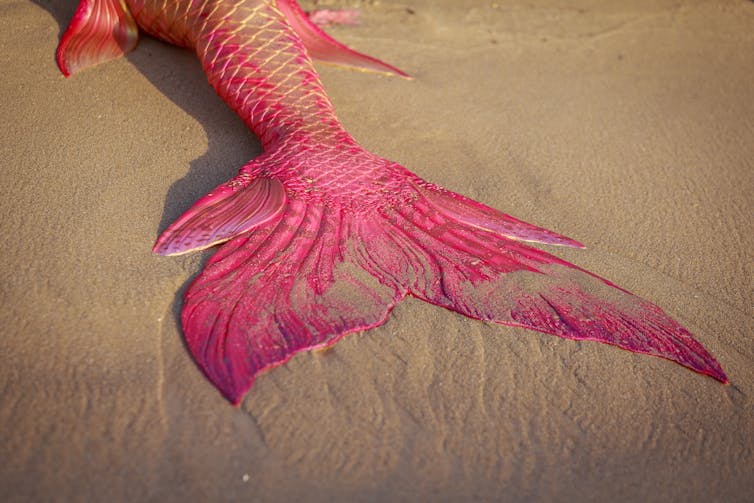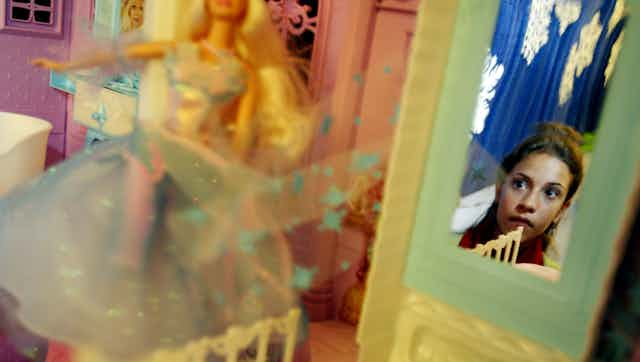Ariel and Barbie have quite a bit in common: They’re both frozen in time, and they both yearn to live as humans do.
The fantastic seascapes and perfect dollhouses of “The Little Mermaid” and “Barbie” might appear whimsical. But I see these settings – and the characters who inhabit them – as figurations of death.
In my forthcoming book, I consider the relationship between mermaids and Barbie dolls. In the case of the 2023 films, I couldn’t help but think about how Ariel and Barbie make the same ironic choice: to leave the stasis of their deathlike existence for a human life – which ends in death.
These dead girls offer insights about living. Embracing death’s inevitability brings some freedom, as well as access to truths about time and the natural world.
‘I am dead yet I live’
Ariel and Barbie are not your typical dead girls – at least in the literary sense.
The dead girl trope goes back to Shakespeare’s Ophelia, who drowns herself after being driven to madness by Hamlet’s erratic, abusive speech. But dead girls have long populated folktales about sleeping beauties and myths of goddesses traversing the underworld.
Today, the trope is often found in noirish mysteries. These narratives frequently prioritize the development of a male protagonist – a detective who grapples with his own mortality while solving a crime that regularly involves sexual violence.
David Lynch’s “Twin Peaks,” which first aired on ABC in 1990, wields this version of the trope. FBI agent Dale Cooper investigates the murder of Laura Palmer, a homecoming queen whose corpse is discovered wrapped in plastic. Though Laura Palmer has been victimized, she isn’t voiceless. She appears in flashbacks and has recorded her feelings and desires in diary entries.
In Showtime’s 2017 reboot, “Twin Peaks: The Return,” the afterlife version of Laura tells Cooper, “I am dead yet I live.”
Ariel and Barbie are their films’ protagonists, and they don’t die via murder. But they nevertheless actualize Laura’s words: Choosing flesh over immortality is to live and die, too.

Dreaming death in fish tails and pink
“Do you guys ever think about death?” asks the character known as “Stereotypical Barbie,” played by Margot Robbie, a few scenes into the film. The irony is that Barbie is already dead, cheerfully doomed to repeat the same pink day, devoid of food, conflict and sex.
Barbie’s dreamworld is home to many iterations of its title character, including Mermaid Barbie. There are also a number of Kens. They are coupled, but they aren’t having sex. As Stereotypical Barbie declares, Barbies don’t have vaginas, and Kens don’t have penises.
Fish tails don’t typically feature vaginas either. The virginal Ariel is stuck in her fin, fathoms below.
Ariel and Barbie don’t get periods and can’t get pregnant. They’ll also never go through menopause.
In their films, the protagonists reject dollified existences and choose human life with its opportunities for sex and unavoidable death. Ariel leaves the ocean’s eternity for the prince’s land-world after she saves him. Barbie sacrifices physical perfection – her own and Ken’s – for the possibility of authentic intimacy and the spontaneity of an aging female body. The latter leads her to visit the gynecologist’s office at the film’s conclusion.
Hollywood films promise happily ever afters, but those weren’t the main draw for audiences of “The Little Mermaid” and “Barbie.”
I think that part of what drove theater attendance this summer was a subconscious attraction to the deathlike repetition of timeless dreamworlds, whether underwater or plastered in pink.
As dead girls, Ariel and Barbie are appealing vessels because, in them, time stops: You can’t be out of time when there is no time to begin with.
A water-bound mermaid and an ageless doll present a “timeout,” especially for girls and women pressured to achieve specific education and other life goals within certain time frames. Fish-tailed mermaids and Barbie dolls are free from ticking biological and career clocks – although they imagine or play at the things determined by those clocks, too. As a doll, Barbie gets to have any and all jobs, trading one for another whenever her player gets bored. She can be a doctor, an astronaut or even president of the United States.
Audiences might go to the movies to escape reality. Yet, Barbie and Ariel choose to enter reality, leaving their respective dreamworlds. Such outcomes make the films relevant to the summer of 2023: The dead girl can’t age, but her perpetual youth signals the future’s promises, even when there is no promise of a future.

‘This sad, vanishing world’
In her fish-tailed state, Ariel sings about wanting to know about fire and its causes, questions applicable to this summer’s reckoning with global warming. Humans have scorched the planet to fulfill a desire for, among other things, plastic – the very material that made Barbie possible.
The unprecedented heat in the summer of 2023 demands that everybody listen to another ticking clock, the one counting down to environmental ruin.
Ariel and Barbie choose to live in the world their audiences inhabit, even though the characters are fully aware that humans are destructive and cause suffering.
“The Little Mermaid” is explicit about how humans hurt the ecosystem, a critique made by Black mermaids in older folk tales and recent literature inspired by them. Ariel and Eric inevitably sail away, leaving her home under the sea and his coastal kingdom. The bittersweet ending suggests they, each equipped with knowledge of the other’s world, will carry insights about environmental harmony to other places.
“The Little Mermaid” and “Barbie,” I believe, reveal a truth found in many sacred stories. If you accept that you are dead already and that time is always passing away, you might gain the freedom to truly embrace the brief life you do have in what the Hindu deity Krishna described as “this sad, vanishing world.”
Or as W.B. Yeats wrote, “Man is in love and loves what vanishes, / What more is there to say?”

